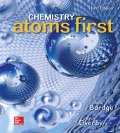
Write the reaction quotient for each of the following reactions.
Interpretation
To drive the reaction quotient (Qc) given the equilibrium reactions.
Concept Introduction:
Reaction quotient: This type of chemical equilibrium reaction proceeds likely to produced, given either the pressure (or) the concentration of the reactants and the products. The value can be compared to the equilibrium constant, to determine the direction of the reaction that is take place. Then reaction quotient (Qc) the indication of Q can be used to determine which direction will shift to reach of chemical equilibrium process.
Balancing of equilibrium reaction: The many of chemical reaction involving for, reversible reaction is occurring backwards and forwards at the time by the same amount, it is balancing point of a chemical reaction, it seems to stop happening when the rates are equal equilibrium has occurred.
Answer to Problem 1PPA
The reaction quotients (Qc) for given the different equilibrium reactions (a-f) are shown below
Explanation of Solution
To find: The reaction quotient should be solved given the equilibrium reactions.
Write and analyze the reaction quotient (Qc) fallowing reactions.
The (Qc) equation is written by multiplying the activities for the species of the products and dividing by the activities of the reactants. If any component in the reaction has a coefficient, indicated above with lower case letters, the concentration is raised to the power of the coefficient. The compare for the given above equation (1 & 2) and should solved above. Furthermore the Qc changes as the reaction progress and is only equal to the equilibrium constant when total system is at same equilibrium.
The reaction quotients (Qc) has solved given the equilibrium reactions.
Want to see more full solutions like this?
Chapter 15 Solutions
Chemistry: Atoms First
- At 1 atm and 25 C, NO2 with an initial concentration of 1.00 M is 3.3103 decomposed into NO and O2. Calculate the value of the equilibrium constant for the reaction. 2NO2(g)2NO(g)+O2(g)arrow_forwardDescribe a nonchemical system that is not in equilibrium, and explain why equilibrium has not been achieved.arrow_forwardCalculate the value of the equilibrium constant for the reaction N2(g)+2O2(g)2NO2(g) if the concentrations of the species at equilibrium are [N2] = 0.0013, [O2] = 0.0024, and [NO2] = 0.00065.arrow_forward
- Given these data at a certain temperature, 2H2(g)+O2(g)2H2O(g)Kc=3.21081N2(g)+3H2(g)2NH3(g)Kc=3.5108 calculate Kc for the reaction of ammonia with oxygen to give N2(g) and H2O(g).arrow_forwardDistinguish between the terms equilibrium constant and reaction quotient. When Q = K, what does this say about a reaction? When Q K, what does this say about a reaction? When Q K. what does this say about a reaction?arrow_forwardConsider the following equilibria involving SO2(g) and their corresponding equilibrium constants. SO2(g) + 12 O2(g) SO3(g) K1 2SO3(g) 2SO2(g) + O2(g) K2 Which of the following expressions relates K1 to K2? (a) K2=K12 (b) K22=K1 (c) K2 = K1 (d) K2 = 1/K1 (e) K2=1/K12arrow_forward
- Given the following descriptions of reversible reactions, write a balanced net ionic equation (simplest whole-number coefficients) and the equilibrium constant expression (K) for each. (a) Liquid acetone (C3H6O) is in equilibrium with its vapor. (b) Hydrogen gas reduces nitrogen dioxide gas to form ammonia and steam. (c) Hydrogen sulfide gas (H2S) bubbled into an aqueous solution of lead(ll) ions produces lead sulfide precipitate and hydrogen ions.arrow_forwardThe equilibrium constant for a reaction decreases as temperature increases. Explain how this observation is used to determine the sign of either H or S.arrow_forwardThe diagram represents an equilibrium mixture for the reaction N2(g) + O2(g) ⇌ 2 NO(g) Estimate the equilibrium constant.arrow_forward
- Write the mathematical expression for the reaction quotient, QC, for each of the following reactions (a) N2(g)+3H2(g)2NH3(g) (b) 4NH3(g)+5O2(g)4NO(g)+6H2O(g) (C) N2O2(g)2NO2(g) (d) CO2(g)+H2CO(g)+H2O(g) (e) NH4CI(s)NH3(g)+HCI(g) (f) 2Pb( NO3)2(s)2PbO(s)+4NO2(g)+O2(g) (g) 2H2(g)+O2(g)2H2O(g) (h) S8(g)8S(g)arrow_forwardWrite the mathematical expression for the reaction quotient, QC, for each of the following reactions: (a) CH4(g)+CI2CH3CI(g)+HCI(g) (b) N2(g)+O2(g)2NO(g) (c) 2SO2(g)+O2(g)2SO3(g) (d) BaSO3(s)BaO(s)+SO2(g) (e) P4(g)+5O2(g)P4O10(s) (f) Br2(g)2Br(g) (g) CH4(g)+2O2(g)CO2(g)+2H2O(l) (h) CuSO45H2O(s)CuSO4(s)+5H2O(g)arrow_forwardFor the following reactions, predict whether the pressure of the reactants or products increases or remains the same when the volume of the reaction vessel is increased. (a) H2O(l)H2O(g) (b) N2(g)+3H2(g)2NH3(g) (c) C2H4(g)+H2O(g)C2H5OH(g)arrow_forward
 Chemistry by OpenStax (2015-05-04)ChemistryISBN:9781938168390Author:Klaus Theopold, Richard H Langley, Paul Flowers, William R. Robinson, Mark BlaserPublisher:OpenStax
Chemistry by OpenStax (2015-05-04)ChemistryISBN:9781938168390Author:Klaus Theopold, Richard H Langley, Paul Flowers, William R. Robinson, Mark BlaserPublisher:OpenStax Chemistry: The Molecular ScienceChemistryISBN:9781285199047Author:John W. Moore, Conrad L. StanitskiPublisher:Cengage Learning
Chemistry: The Molecular ScienceChemistryISBN:9781285199047Author:John W. Moore, Conrad L. StanitskiPublisher:Cengage Learning
 Chemistry: An Atoms First ApproachChemistryISBN:9781305079243Author:Steven S. Zumdahl, Susan A. ZumdahlPublisher:Cengage Learning
Chemistry: An Atoms First ApproachChemistryISBN:9781305079243Author:Steven S. Zumdahl, Susan A. ZumdahlPublisher:Cengage Learning ChemistryChemistryISBN:9781305957404Author:Steven S. Zumdahl, Susan A. Zumdahl, Donald J. DeCostePublisher:Cengage Learning
ChemistryChemistryISBN:9781305957404Author:Steven S. Zumdahl, Susan A. Zumdahl, Donald J. DeCostePublisher:Cengage Learning Chemistry: Principles and PracticeChemistryISBN:9780534420123Author:Daniel L. Reger, Scott R. Goode, David W. Ball, Edward MercerPublisher:Cengage Learning
Chemistry: Principles and PracticeChemistryISBN:9780534420123Author:Daniel L. Reger, Scott R. Goode, David W. Ball, Edward MercerPublisher:Cengage Learning





